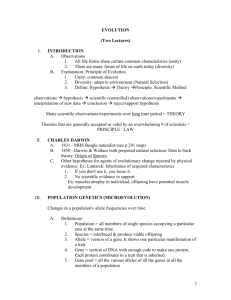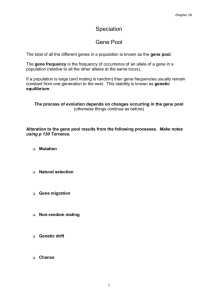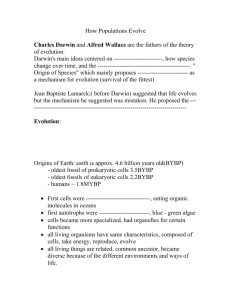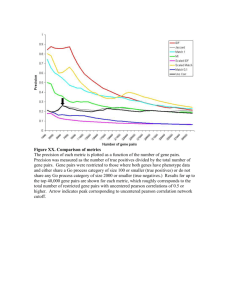Lecture 24
advertisement
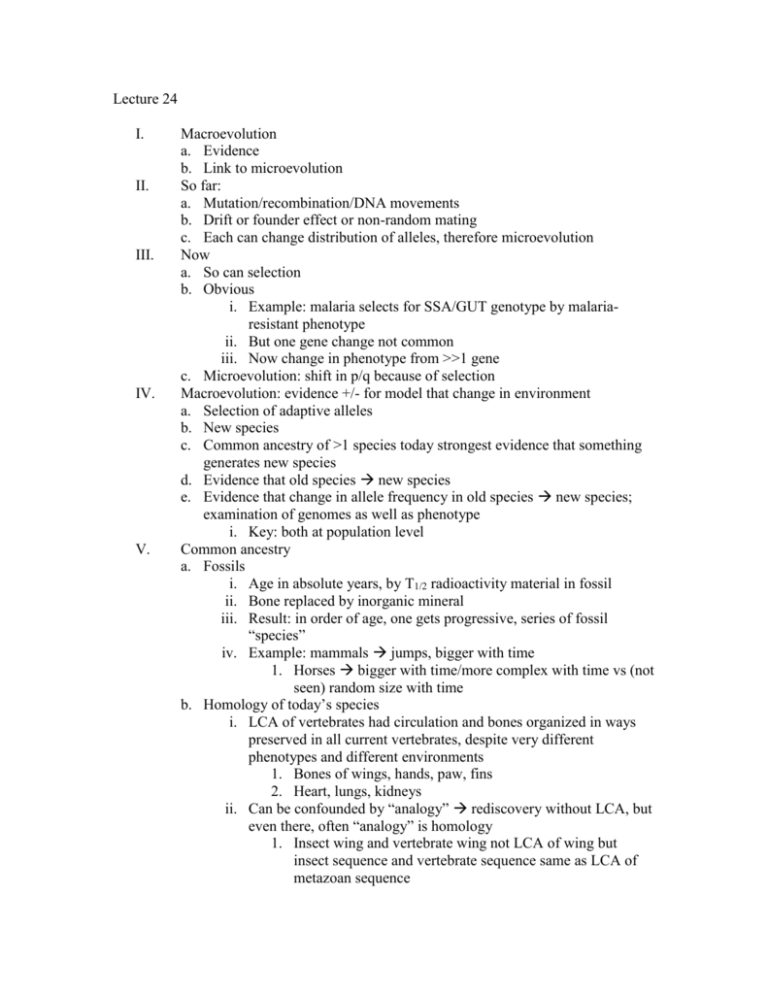
Lecture 24 I. II. III. IV. V. Macroevolution a. Evidence b. Link to microevolution So far: a. Mutation/recombination/DNA movements b. Drift or founder effect or non-random mating c. Each can change distribution of alleles, therefore microevolution Now a. So can selection b. Obvious i. Example: malaria selects for SSA/GUT genotype by malariaresistant phenotype ii. But one gene change not common iii. Now change in phenotype from >>1 gene c. Microevolution: shift in p/q because of selection Macroevolution: evidence +/- for model that change in environment a. Selection of adaptive alleles b. New species c. Common ancestry of >1 species today strongest evidence that something generates new species d. Evidence that old species new species e. Evidence that change in allele frequency in old species new species; examination of genomes as well as phenotype i. Key: both at population level Common ancestry a. Fossils i. Age in absolute years, by T1/2 radioactivity material in fossil ii. Bone replaced by inorganic mineral iii. Result: in order of age, one gets progressive, series of fossil “species” iv. Example: mammals jumps, bigger with time 1. Horses bigger with time/more complex with time vs (not seen) random size with time b. Homology of today’s species i. LCA of vertebrates had circulation and bones organized in ways preserved in all current vertebrates, despite very different phenotypes and different environments 1. Bones of wings, hands, paw, fins 2. Heart, lungs, kidneys ii. Can be confounded by “analogy” rediscovery without LCA, but even there, often “analogy” is homology 1. Insect wing and vertebrate wing not LCA of wing but insect sequence and vertebrate sequence same as LCA of metazoan sequence VI. VII. c. Vestigial structures in today’s species i. Like junk DNA, junk phenotype ii. Once may have had a selective function in an LCA iii. Example: whale has pelvis, panda has thumbs that do not work, humans have lower back with extra vertebra iv. All not useful currently, once useful, so stuck in time d. Parallel adaptation i. If there’s a change in the environment change p/q change in phenotype, then similar environment change should select similar change in phenotype e. Island patterns i. Darwin Galapagos finches ii. Island forms resemble but are not identical to nearest island neighbors iii. All are most similar to nearest mainland species iv. Mainland LCA of island species How do old species become new species? a. Prior question: what is the lifetime of a species from fossil evidence? i. Varies widely, shorter when change in environment change is greater (stronger selection); physical separation founders either die of establish near p/q very fast b. During the lifetime of a species, it has a stable niche mating place in space and time c. If selection is against the middle, then two populations form that are i. More homozygous ii. Non-overlapping in phenotype iii. Example: mimicker insect resembles poisonous insect d. Gene pool isolation is key i. Does a new species simple emerge? ii. No, a species is a population, never an individual, it has a gene pool, not a genome iii. So how can a new species emerge from an old one? iv. Look at margin of species with nearest next species (nearest in form and behavior) v. What keeps these gene pools apart? vi. Mechanism of isolation of gene pools, mechanism of separation vii. Change in p/q that isolates gene pool: microevolution macroevolution Multiple alleles a. No reason why there exist only one or two versions of a gene b. More than 1 necessary to be seen as allelic choice c. However, there exist >>2 alleles d. Example: not “blood” but blood, some people can share blood, others cannot, when not, recipient sees donor blood as foreigner e. Discussion in class about blood types f. All possible phenotypes can accept type O VIII. IX. X. I. II. Gene interactions a. More than one gene more than one phenotype b. Genes can lose function c. With enough genes, phenotypes get continuous variation d. Like 2 die with six sides e. Dosage incomplete dominance, example of primrose f. Nondisjunction Down Syndrome g. Environment interacts with allelic choice Conclusion a. If human change is due to one allelic choice (generally with 2 alleles) a lot can be perfected b. If human change is due to >>1 allelic choice with >>2 alleles, little to nothing can be predicted to be determined by parental alleles c. Entire genome precious d. Genetic line precious e. Can there be more than two sexes? Genetic disorders a. Pick out human groups b. American, Europeans, Asians, Africans, etc c. Different groups more vulnerable for different diseases d. Discussion and examples in class Isolation of gene pool within larger population a. Not much has to change b. Sterile offspring Post zygotic i. Failed recombination between species A and B during meiosis ii. Example: horse and donkey mate offspring is a sterile mule c. Mating does not occur pre zygotic i. Physical separation ii. Temporal separation d. No need for visible, large change to initiate gene pool isolation i. One mutation sperm and egg cannot fuse divergence of >>2 species from one new species ii. Why? iii. Because random mutations thereafter will be different in two populations, can never re-merge into one gene pool Back to the genome a. One mechanism of isolating gene pools and enhancing new function at the same time is unequal cross over i. Anatomy of genome diagram ii. Transposon, sequences that pops and inserts at equilibrium present between genes iii. Meiosis I these line up, but TNs are like a stutter, cand lead to unbalance iv. Class discussion b. Silent copies III. i. Mutation can inactivate <n-1 copies in a family pseudo genes ii. mRNA cDNA integration Macroevolution a. Today life stacked in hierarchy of similarities b. Kingdom c. Phylum d. Class e. Order f. Family g. Genus h. Species i. Model of LCA j. Discussion in class of origins and evidence

